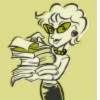 Seuss, Dr. 1960. GREEN EGGS AND HAM. New York: Random House. ISBN 0-394-80016-8
Seuss, Dr. 1960. GREEN EGGS AND HAM. New York: Random House. ISBN 0-394-80016-8Summary
In this classic Dr. Seuss tale, a nameless naysayer is coaxed into trying something new. Sam, an omnipresent character, attempts to serve him green eggs and ham in varying venues and with different companions. Throughout the story, the object of Sam’s persistence insists he does not like green eggs and ham. Finally, the character relents and discovers that he does like green eggs and ham after all. Seuss’ one-of-a-kind use of rhyme, meter, and illustration have made this story of the value of open-mindedness a timeless classic. Highly recommended for 4 year olds with long attention spans through 9 year old readers.
Analysis
While many of Dr. Seuss’ masterpieces rely on nonsensical words and unpredictable phrases, Green Eggs and Ham takes advantage of predictable text to encourage and facilitate early readers’ success. The predictability stems not only from the flawless rhyme, but also from repetitive phrases. Few authors are able to employ predictability to this extent without compromising story quality. However, Dr. Seuss succeeds in spinning a tale in which the reader can hardly wait to find out the conclusion all the while using rhyme and repetition.
As with all well-constructed picture books, Green Eggs and Ham would not be a complete tale without the illustrations. The first three pages of the story are illustrations of a curious fellow riding Seussian beasts back and forth. It is not until page 4 that text becomes prevalent with the main character exploding, “That Sam-I-am! That Sam-I-am! I do not like that Sam-I-am!” Thus, the tone is set for the entire story. The perfect coupling of text with pictures also helps developing readers. Not sure what that word is? It starts with an “h” and that’s a picture of a house. And that word? Well it rhymes with house, starts with “m” and that’s a picture of a…mouse! This story is an emergent reader’s dream come true—and it’s a fun tale to boot!
Connections
Other books by Dr. Seuss:
One Fish, Two Fish, Red Fish, Blue Fish
Horton Hears a Who
The Lorax


